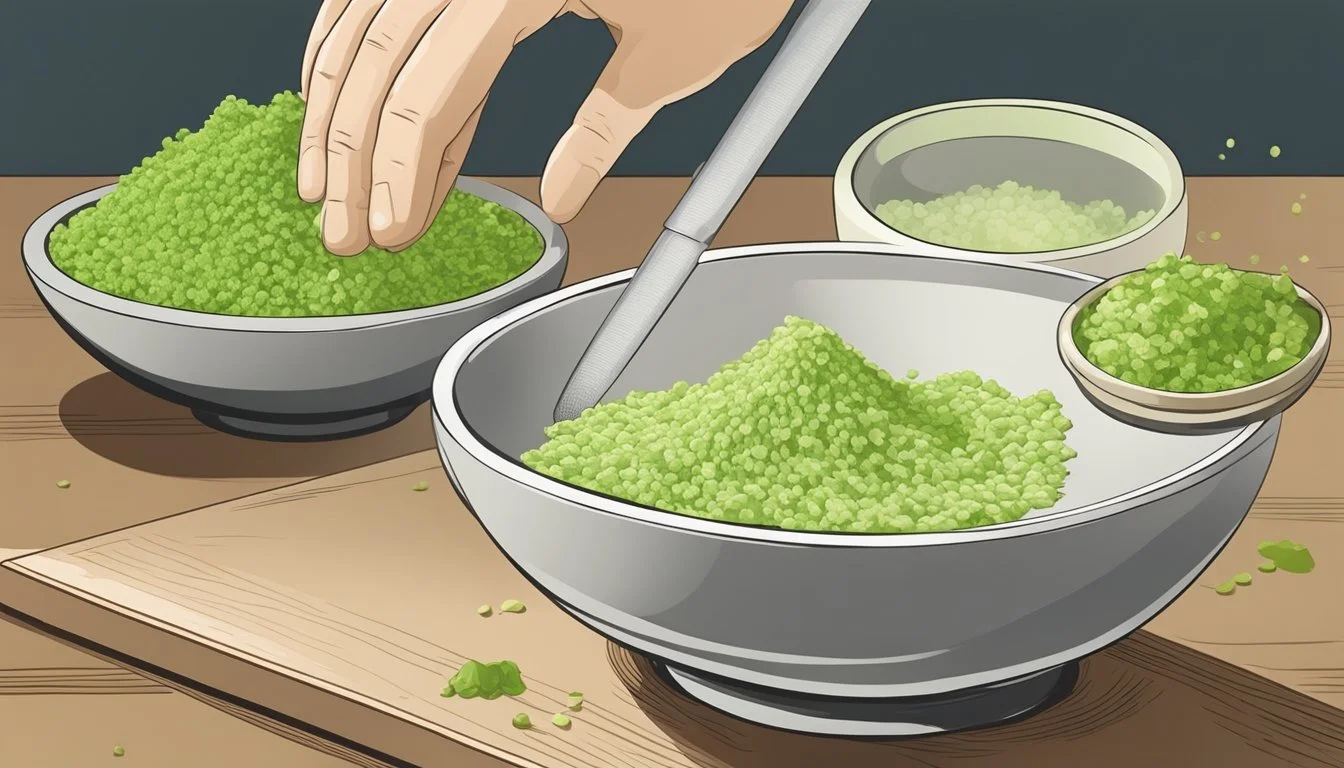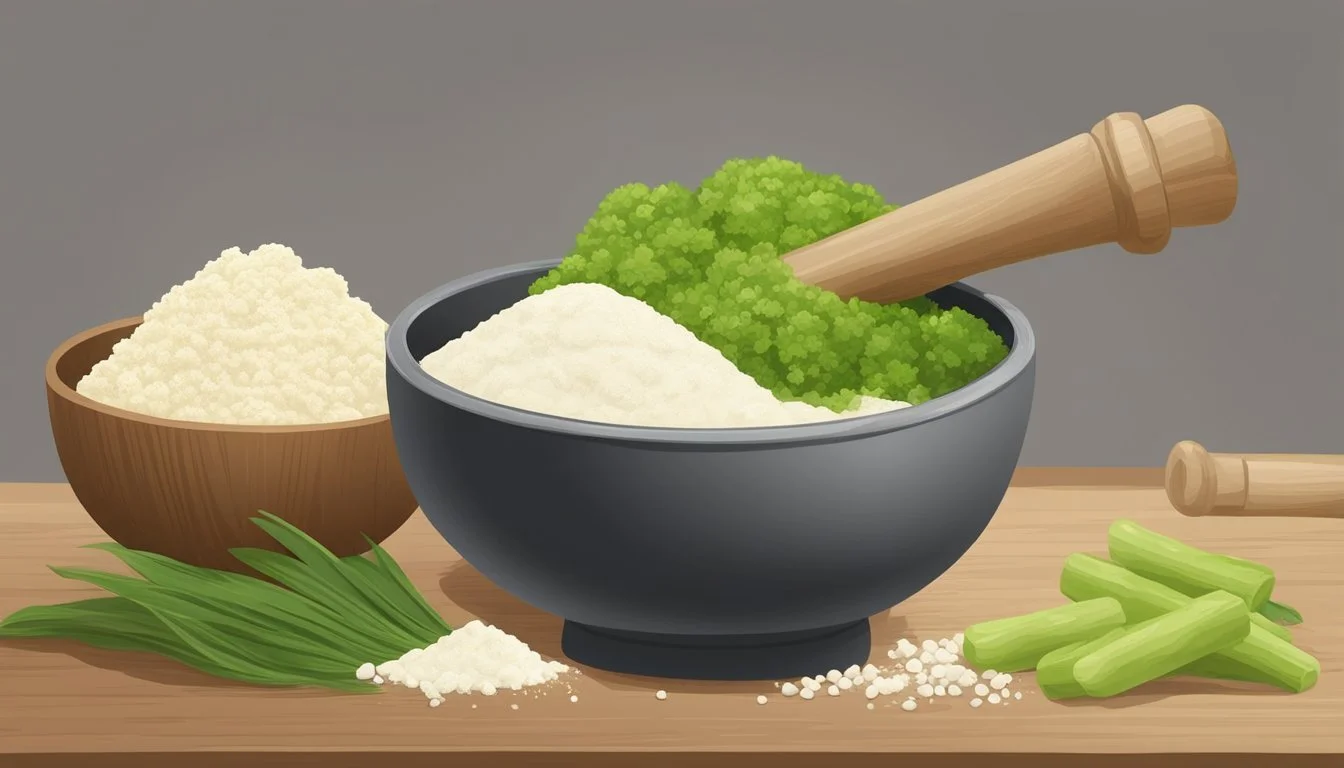How to Substitute Horseradish for Wasabi
Simple Swap Guide
Horseradish and wasabi are often thought of as interchangeable in culinary circles due to their similar fiery qualities. But, while they both belong to the Brassicaceae family and possess a pungent taste and nasal-clearing heat, they are distinct in flavor and composition. Wasabi, traditionally associated with Japanese cuisine, is derived from the rhizome of the Wasabia japonica plant, known for its rarity and often high cost when fresh. Horseradish, on the other hand, comes from the Armoracia rusticana plant and is more readily available in many parts of the world.
When a recipe calls for wasabi, horseradish stands as the most accessible and effective substitute. It mirrors the sharpness and intensity that wasabi brings to dishes, particularly in the form of a freshly grated root. However, not everyone can get their hands on fresh horseradish, making prepared horseradish an acceptable alternative despite its milder nature. It's important for enthusiasts looking to replicate that characteristic wasabi experience to use horseradish in a way that closely resembles the authentic taste and heat level.
Understanding Horseradish
Horseradish is a pungent condiment derived from a root vegetable, used freshly grated or processed in various culinary applications. This section delves into its origins, diverse varieties, and nutritional profile.
Origins and Characteristics
Horseradish, known scientifically as Armoracia rusticana, is a root vegetable in the Brassicaceae family. Its origins trace back to southeastern Europe and western Asia. Horseradish's flavor is characterized by a potent, spicy heat, released when the root is cut or grated. This is due to the presence of volatile compounds called isothiocyanates. The root is typically grated and used fresh or preserved to retain its heat, as the flavor can quickly dissipate.
Texture: Coarse and fibrous when grated
Heat Profile: Intense, clears the sinuses, dissipates quickly
Horseradish Varieties
There are a few variants of horseradish, distinguished by their color:
White Horseradish: Derived from the main species, it is the most common and potent variety.
Black Horseradish: Also known as black radish (Raphanus sativus L. var. niger), it has a rougher texture and a slightly different flavor profile.
Daikon: While not a true horseradish, this large East Asian radish can sometimes be used as a milder substitute for it.
Other root vegetables, such as parsnips, can mimic the texture of horseradish but do not replicate its distinctive heat.
Nutritional Composition
Horseradish is not only valued for its pungency but also its nutritional benefits. It is low in calories and contains dietary fiber, vitamin C, and minerals such as potassium and iron. These components contribute to its overall nutritional value, making it a healthful addition to diets.
Fiber: Supports digestive health
Iron: Essential for healthy blood cells
Vitamin C: Antioxidant properties, immune support
The following table summarizes the nutritional composition of horseradish:
Nutrient Value per 100g Calories 48 Fiber 3.3g Vitamin C 25mg Iron 0.42mg
Understanding the properties of horseradish is essential for anyone looking to substitute it for wasabi in culinary applications. The root's heat, texture, and nutritional benefits have earned it a spot in kitchens worldwide.
Understanding Wasabi
Before delving into substitutions, it's crucial to comprehend what true wasabi is, how it's grown, and its traditional culinary roles, which notably differ from its common imitations.
Real Vs. Fake Wasabi
True wasabi, or Japanese horseradish, comes from the Wasabia japonica plant. The rarity and expense of growing it contributes to its value. Many wasabi pastes found in stores or served with sushi (What wine goes well with sushi?) and sashimi outside Japan are actually a mixture of horseradish, mustard flour, and green food coloring. This concoction aims to mimic the flavor and appearance of real wasabi, but typically has a different, more pungent taste and lacks the nuanced flavor profile of fresh wasabi.
Real Wasabi:
Wasabi japonica plant
Grown in Japan
Subtle, herbal heat
More expensive
Fake Wasabi:
Horseradish and mustard
Green food coloring
Harsher taste
Widely available and less costly
Wasabi Cultivation
Wasabi cultivation is a labor-intensive process that requires a cool, humid environment with freshwater flowing, akin to conditions in the mountains of Japan. It can take over a year for a wasabi root to mature. Fresh wasabi is a pale green rhizome that is finely grated before use. Due to its difficulty to grow and the precise conditions needed, wasabi is typically scarce and expensive outside of Japan.
Cultivation Key Points:
Cool, humid climate required
Freshwater streams
Over a year to mature
Expensive due to growth complexity
Culinary Uses of Wasabi
In Japanese cuisine, wasabi is traditionally served with dishes like sushi and sashimi. Its unique, pungent heat complements the delicate flavors of raw fish without overshadowing them. Authentic wasabi has a complex flavor profile that dissipates quickly after grating, which is why it's often prepared fresh at high-end restaurants. Wasabi can also be found in powdered form, which is mixed with water to form a paste when fresh wasabi is unavailable.
Culinary Uses:
Complements sushi and sashimi
Served in high-end Japanese restaurants
Can be reconstituted from a powder to a paste
Horseradish as a Wasabi Substitute
Horseradish is a versatile root with a fiery pungency that makes it an ideal substitute for wasabi. It can mimic the flavor profile and intensity required in dishes traditionally calling for wasabi.
Comparing Flavors
The flavor profile of horseradish is similar to that of wasabi, with both roots imparting a sharp, sinus-clearing heat that is brief and intense. While wasabi has a slightly more complex flavor with herbal undertones, horseradish offers a straightforward, clean heat. To achieve a flavor that resembles wasabi, one might consider adding spicy brown mustard to the grated horseradish, as this mustard contains mustard seeds which contribute an additional spicy complexity.
Adjusting Spice Levels
The potency of horseradish can vary, so one should adjust the quantity used according to the desired spice level. Freshly grated horseradish is stronger and more pungent than prepared horseradish sauce, which is milder due to the addition of other ingredients. When substituting, start with a small amount and adjust to taste. A touch of Dijon, which also contains mustard seed, can be added for heat modulation and to enhance the overall pungency.
Similarities in Texture and Use
In terms of texture, both wasabi and horseradish should be finely grated for use. They are often used in similar contexts, such as alongside sushi or added to sauces and dressings. The freshly grated horseradish mimics the texture of ground wasabi paste when mixed to the correct consistency. The key to proper preparation is achieving a paste-like texture that can be easily spread or blended into dishes.
When replacing wasabi with horseradish in recipes, remember that the heat from both condiments diminishes quickly once grated, so it is best to prepare fresh horseradish close to the time of serving to maintain its vibrant pungency.
Additional Horseradish-Based Substitutes
Substituting horseradish for wasabi can incorporate a variety of similar-tasting alternatives, including various mustards and other spices that maintain the desired pungency and heat. The following subsections lay out specific options, their unique properties, and how they can be integrated to mimic horseradish's distinct flavor.
Mustard Variants as Substitutes
Mustard, a close relative to horseradish, shares its pungent qualities. One can opt for Dijon mustard, a suitable stand-in with a complex, sharp taste. For a more intense heat, spicy brown mustard or brown mustard seed is recommended, providing a robust flavor akin to horseradish. To achieve a good balance, use these mustard variants in a 1:1 substitution ratio when replacing horseradish in recipes.
Dijon Mustard: Creamy with a sharp taste, ideal for vinaigrettes and sauces.
Spicy Brown Mustard: Best for hearty dishes, such as roasts and sandwiches.
Yellow Mustard: Milder, but can be enhanced with a sprinkle of brown mustard seeds.
Alternative Spicy Condiments
For those seeking a horseradish alternative that still packs heat, hot sauce or karashi (Japanese spicy mustard) can serve as viable substitutes. Karashi is potent and can match the intensity of horseradish. When incorporating hot sauce, start with small quantities and incrementally increase until the desired heat level is achieved.
Hot Sauce: Begin with half the amount of horseradish called for, adding more to taste.
Karashi: Use sparingly, as it is hotter than most mustards and can overpower other flavors.
Combining with Other Ingredients
Combining ginger paste or vinegar with the above-mentioned mustard variants can emulate horseradish’s sharpness and tang. Incorporating fresh ginger can also introduce a warm, spicy element. Mix these components with care, starting with smaller proportions to prevent overwhelming the dish.
Ginger: Adds a warm, spicy note; blend ginger paste with prepared mustard.
Vinegar: Enhances pungency; a touch of vinegar with spicy mustard can mimic horseradish's tang.
Creative Culinary Applications
When substituting wasabi with horseradish in recipes, the intention is to replicate wasabi’s unique heat and sharpness. Horseradish can be a versatile component in various dishes beyond its traditional uses, offering a similar zesty punch.
Horseradish in Sushi and Sashimi
For sushi and sashimi, freshly grated horseradish can be a suitable stand-in for the green paste typically seen with raw fish dishes. (What wine goes well with raw fish dishes?) It's advisable to mix the grated horseradish with a hint of sugar and soy sauce for a balanced, flavorful kick. This blend can be used as a dollop on top of sushi or as a tangy streak alongside sashimi slices.
Using Horseradish in Cocktails
Horseradish adds a spicy depth to cocktails, such as the classic Bloody Mary. A small amount of prepared horseradish can be shaken or stirred into the drink for an invigorating twist. Additionally, horseradish can enhance cocktail sauces, providing a sharp taste that complements seafood like shrimp and oysters.
Innovative Horseradish Condiments
Salads and sandwiches may benefit from an innovative spread or dressing featuring horseradish. Mixing horseradish with umeboshi paste and yuzu pepper creates a tasty and uncommonly used condiment that offers a different palate experience. Similarly, horseradish combined with yuzu juice and a touch of sweetness can result in a refreshing dressing for green salads.
Preparing Homemade Horseradish Substitutes
In this section, they will learn how to create alternatives to horseradish that mimic the pungency and heat of wasabi. The focus will be on recipes that can be made at home and methods to keep the substitutes fresh for an optimal shelf life.
Recipes for Homemade Wasabi
For individuals looking to make their own wasabi-like substitute from horseradish, here are the steps:
Grate fresh horseradish root to yield one tablespoon.
Blend the grated horseradish with one teaspoon of sugar and a pinch of salt to balance the flavors.
Add two teaspoons of vinegar (preferably rice vinegar for a milder taste) to achieve the paste-like consistency characteristic of wasabi.
Incorporate a small amount of prepared horseradish if available, to intensify the heat.
Mix in a bit of fresh ginger zest for an additional layer of flavor that complements the fiery kick of wasabi.
For color, a pinch of dried green food coloring can be added; however, this is optional and solely for aesthetic purposes.
The result should be a potent and flavorful homemade horseradish substitute, with the fiery punch needed to replace wasabi in most dishes.
Storage and Shelf Life
To store the homemade horseradish substitute:
Transfer the mixture to an airtight container to minimize exposure to air.
Refrigerate immediately; the cold environment helps maintain freshness.
In terms of shelf life:
Expect the homemade substitute to last approximately one to two weeks in the refrigerator.
Keep in mind that the flavor’s intensity may diminish over time, so it’s best when used fresh.
By following these guidelines, they can ensure their homemade horseradish substitute retains its intended flavor and potency for as long as possible.
Health Considerations and Allergies
When substituting horseradish for wasabi, it's important for individuals to consider the relative strength and potential allergens of these condiments, especially when dealing with sensitive palates and the implications of allergic reactions.
Managing Heat for Sensitive Palates
Horseradish and wasabi both pack a potent punch when it comes to heat, but they do so through different compounds. Horseradish generates its heat primarily from compounds called isothiocyanates, which create a sharp, penetrating sensation that can often lead to a watery reaction in the eyes and nose. In comparison, wasabi produces a similar effect, though some find its heat slightly more tolerable. For those with sensitive palates:
Use a smaller quantity of horseradish than wasabi to start, adjusting to taste.
Consider incorporating mild flavor elements like sauerkraut or daikon to balance the heat.
Mustard can offer a similar heat to wasabi and be adjusted to reduce sharpness.
Allergic Reactions to Horseradish and Wasabi
Horseradish and wasabi might cause allergic reactions in some individuals, which may present through symptoms such as itching or swelling. It's important to recognize that:
Wasabi served outside Japan is often a mixture of horseradish, mustard, and green food coloring, which could affect individuals with sensitivities to any of these components.
Pure wasabi is relatively rare and can be expensive, but for those allergic to horseradish, authentic wasabi may be better tolerated.
Cross-reactivity should be considered, especially if there are known allergies to other plants within the Brassicaceae family, which includes mustards, cabbage, and ginger.
Although not common, severe reactions akin to those caused by chili peppers, including the extremely hot Carolina Reaper, should be immediately treated by medical professionals.
Conclusion
When substituting horseradish for wasabi, one must consider the flavor profile and the impact on the dish's appearance. Horseradish shares a similar heat intensity and pungency with wasabi, which is why it is a favored substitute. While both are often paired with prime rib and sushi, their differences are notable. Wasabi is traditionally more expensive than horseradish, and its vibrant green color is distinctive.
For those looking for an alternative to wasabi, whether due to cost or availability, horseradish is a readily available and suitable replacement. To closely mimic wasabi's appearance, a touch of green food coloring can be added to the grated horseradish. This can be especially useful for dishes where presentation is key.
It's important to consider that while horseradish can replace wasabi to some extent, each ingredient has unique characteristics that may slightly alter the final taste of a dish. Enthusiasts seeking an authentic experience may still prefer original wasabi. However, horseradish remains a strong contender for those needing a substitute that is both accessible and cost-effective.







